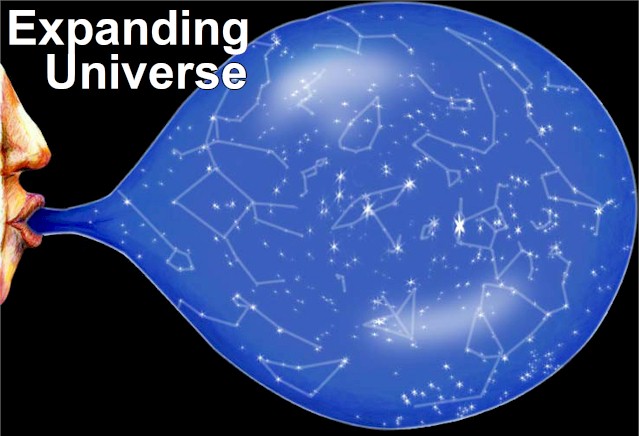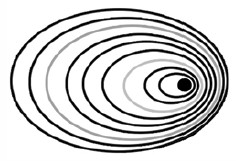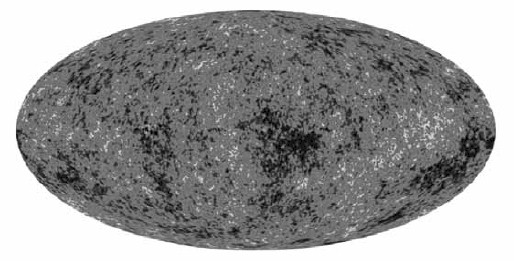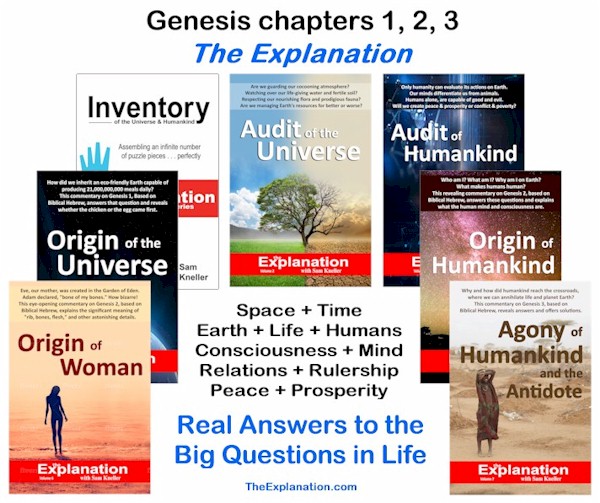Contents
The Expanding Universe: what mysterious force causes it to grow forever?

The Expanding Universe—growing, growing, growing with all the astral bodies staying in their relative same place. (Image: Courtesy of SLAC and Nicolle Rager)
Today, 13.8 billion years after Big Bang, the matter in the original pinhead is still speeding outward, and its outward thrust will never end. That’s why we call it our expanding universe. Strange, because every explosion on Earth reaches an outward point and then collapses inward, whereas the Big Bang explosion takes an entirely different direction.
(Inventory of the Universe, chapter 1.9)
Think of the expanding universe as a rubber balloon (as scientists have suggested) into which the primordial soup was poured, and imagine that you are sticking pins into its surface. Now pour more liquid in.
The balloon stretches outward and the pins (representing galaxies) move farther away from each other, but as the balloon universe expands, the pins/astral bodies remain in the same location, one to another, even though they move further apart.
Consider this: if the speed of the expansion of our universe were just one ten-thousandth slower, the expansion would have stopped when the universe was 30,000 years old.
This is the era of atomic nuclei, when the temperature was still 10,000 degrees Celsius—too hot for electrons to bond with nuclei, too hot for all the atomic processes, and too hot for our “rubber universe.”
If the expansion were one-millionth faster, the point particles and all matter in the universe would have been scattered “like dust in the wind,” spread in all directions so that it could never condense into galaxies. That is the reality of the Big Bang.
But in our present moment, we have to ask: why is the universe expanding at just such a speed? Why should it be so? How do we know it is so?
Science showed us the first surprising inkling of evidence for an expanding universe in 1920, when Edwin Hubble measured the spectral chromatography of Cepheids, or pulsating stars. Hubble discovered the red-to-blue wavelength. This is similar to what’s known as the Doppler effect.

If you’re in your car (the dot in the ellipses above) and you hear an ambulance siren (the ripples on either side), you can tell it’s getting closer because the sound gets shriller, and as it passes you it gets duller.
That’s because the sound waves get shorter as they approach, raising the sound pitch, and longer as they recede, lowering the pitch. Because of this, you can tell if the ambulance is approaching or moving away. Likewise, with the astral bodies.
We now know that the astral bodies are receding from Earth in all directions and that farther the bodies are from the center, the faster they travel.
Remember that the pinhead, like a cup of hot tea, was heated to the extreme. Given time, however, it cools off like the tea until it reaches room temperature (or colder, if you want iced tea). The scenario is similar with the seething heat from the Big Bang.
As elementary particles whip through space, they cool to three degrees Kelvin above absolute zero, which is -273 degrees Celsius (zero degrees Kelvin). Three degrees Kelvin is also an important number for our purposes—one which figures in one of the major proofs of the Big Bang: the fossil echo.
In 1960, Arno Penzias and Robert Wilson were calibrating their telescope by pointing it at a distant star. “By mistake,” their equipment picked up a wavelength of energy with a temperature of three degrees Kelvin.
Further observations led them to realize that no matter where they pointed their telescopic thermometer, the detectable wavelength was three degrees Kelvin. It existed indelibly, like the impression of a prehistoric trilobite in rock.
This is now called the fossil echo of Big Bang. It’s the residual temperature that remains throughout the universe after 13.8 billion years, just as the tea in the cup would be a couple of degrees above room temperature at a given point in its cooling process. We can look through the COBE Satellite to further illuminate the tea analogy.
In 1992, NASA’s hypersensitive COBE satellite took a panoramic photograph of this fossil echo, which has been greatly magnified and honed by succeeding WMAP (2003) and Planck (2013) satellite missions. Think of a wall of adobe with all its ridges and bumps, or of paint with air bubbles in it.
If you traveled to 1992 and eavesdropped on the scientists, you would learn that the scientific team previously thought the universe would be uniform like perfectly mixed concrete, and instead found “lumps”—regions in space—differing by one-millionth of a degree in temperature as witnessed by the image below (different shades for different temperatures).
The takeaway point here is that matter clustered together and condensed into galaxies.

The clustered galaxies are anything but equally spread over the night sky
The fossil echo shows clusters huddling together. In other words, the myriad galaxies are anything but equally spread over the night sky. They’re bunched together with huge, varying amounts of space separating them.
Our universe is not homogenous.NASA scientists concluded that if our universe had been too homogenous at the time of the beginning, all the particles could not have come in contact with each other without a mysterious period of inflation—ultra-rapid expansion—that happened when the universe was relatively small. Nobody knows what powered the inflation, yet conditions at that point of the Big Bang helped “inflate” matter, specifically the point particles.
Galacti rewinds the universal playback to a billion years after the Big Bang, a time in which that fourth force, gravity, pulls point particles into clusters that form galaxies of stars. Over time, hydrogen and helium atoms burning within stars cause stars to explode—a smaller version of the Big Bang—and spread matter into space. Subsequently, this matter coalesces into new stars and planets that make up galaxies such as the Milky Way.
This post is an excerpt from chapter 1.9 of Inventory of the Universe.
Dig Deeper into The Explanation
Online Study Courses to Uncover the Mystery of Adam and Eve’s Nakedness… with no fuss. Free video mini-course revealing the God-intended meaning of Scripture via Biblical Hebrew. It’s so easy, it’ll blow you away. Join now and add new motivation to your Bible study.
Join The Explanation Newsletter to stay informed of updates. and future events. No obligations, total privacy, unsubscribe anytime, if you want.
The Explanation series of seven books. Free to read online or purchase these valuable commentaries on Genesis 1-3 from your favorite book outlet. E-book and paperback formats are available. Use this link to see the details of each book and buy from your favorite store.

Since you read all the way to here… you liked it. Please use the Social Network links just below to share this information from The Explanation, The Expanding Universe, Growing, Forever Growing Quickly



Trackbacks/Pingbacks